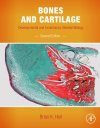Textbook
Out of Print
By: Brian Keith Hall(Author)
760 pages, b/w photos, b/w illustrations, tables
![Bones and Cartilage Bones and Cartilage]()
Click to have a closer look
About this book
Contents
Biography
Related titles
Recommended titles
About this book
Bones and Cartilage provides the most in-depth review ever assembled on the topic. It examines the function, development and evolution of bone and cartilage as tissues, organs and skeletal systems. It describes how bone and cartilage is developed in embryos and are maintained in adults, how bone reappears when we break a leg, or even regenerates when a newt grows a new limb, or a lizard a tail.
Bones and Cartilage also looks at the molecules and cells that make bones and cartilages and how they differ in various parts of the body and across species. It answers such questions as "Is bone always bone?" "Do bones that develop indirectly by replacing other tissues, such as marrow, tendons or ligaments, differ from one another?" "Is fish bone the same as human bone?" "Can sharks even make bone?" and many more.
Contents
Epigraph
Preface
Table of Contents
PART I - SKELETAL TISSUES
Chapter 1 - Types of Skeletal Tissues
Chapter 2 - Bone
Chapter 3 - Cartilage
PART II - NATURAL EXPERIEMENTS
Chapter 4 - Invertebrate Cartilages
Chapter 5 - Intermediate Tissues
Chapter 6 - An Evolutionary Perspective
Part III - UNUSUAL MODES OF SKELETOGENESIS
Chapter 7 - Horns and Ossicones
Chapter 8 - Antlers
Chapter 9 - Tendons and Sesamoids
PART IV - STEM CELLS
Chapter 10 - Embryonic Stem Cells
Chapter 11 - Stem Cells in Adults
PART V - SKELETOGENIC CELLS
Chapter 12 - Osteo- and Chondroprogenitor Cells
Chapter 13 - Dedifferentiation Provides Progenitor Cells for Jaws and Long Bones
Chapter 14 - Dedifferentiation and Urodele Limb Regeneration
Chapter 15 - Cells to Make and Cells to Break:
PART VI - EMBRYONIC ORIGINS
Chapter 16 - Skeletal Origins: Somitic Mesoderm
Chapter 17 - Skeletal Origins: Neural Crest
Chapter 18 - Epithelial-Mesenchymal Interactions: Jaws
PART VII - GETTING STARTED
Chapter 19 - The Membranous Skeleton: Condensations
Chapter 20 - From Condensation to Differentiation
Chapter 21 - Skulls, Eyes and Ears: Condensations and Tissue Interactions
PART VIII - SIMILARITY AND DIVERSITY
Chapter 22 - Chondrocyte Diversity
Chapter 23 - Cartilage Diversity
Chapter 24 - Osteoblast and Osteocyte Diversity
Chapter 25 - Bone Diversity
PART IX - MAINTAINING CARTLAGE IN GOOD TIMES AND BAD
Chapter 26 - Maintaining Differentiated Chondrocytes
Chapter 27 - Maintenance Awry: Achondroplasia
Chapter 28 - Restarting Mammalian Articular Chondrocytes
Chapter 29 - Repair of Fractures and Regeneration of Growth Plates
PART X - GROWING TOGETHER
Chapter 30 - Initiating Skeletal Growth
Chapter 31 - Form, Polarity and Long-Bone Growth
Chapter 32 - Long Bone Growth: a Case of Crying Wolff?
PART XI - STAYING APART
Chapter 33 - The Temporomandibular Joint and Synchondroses
Chapter 34 - Sutures and Craniosynostosis
PART XII - LIMB BUDS
Chapter 35 - The Limb Field and the AER
Chapter 36 - Adding or Deleting an AER
Chapter 37 - AERs in Limbed and Limbless Tetrapods
PART XIII - LIMBS AND LIMB SKELETONS
Chapter 38 - Axes and Polarity
Chapter 39 - Patterning Limbs and Limb Skeletons
Chapter 40 - Before Limbs There Were Fins
PART XTV - BACKBONES AND TAILS
Chapter 41 - Vertebral Chondrogenesis: Spontaneous or Not?
Chapter 42 - The Search for the Magic Bullet
Chapter 43 - Tail Buds, Tails and Tail-lessness
PART XV - EVOLUTIONARY SKELETAL BIOLOGY
Chapter 44 - Evolutionary Experimentation Revisited
Customer Reviews
Biography
Brian Hall has been interested in and studying skeletal tissues since his undergraduate days in Australia in the 1960s. Those early studies on the development of secondary cartilage in embryonic birds, first published in 1967, have come full circle with the discovery of secondary cartilage in dinosaurs: bird watching really is flying reptile watching. Skeletal tissue development and evolution, the embryonic origins of skeletal tissues (especially those that arise from neural crest cells), and integrating development and evolution in what is now known as evo-devo have been his primary preoccupations over the past 50+ years.




































